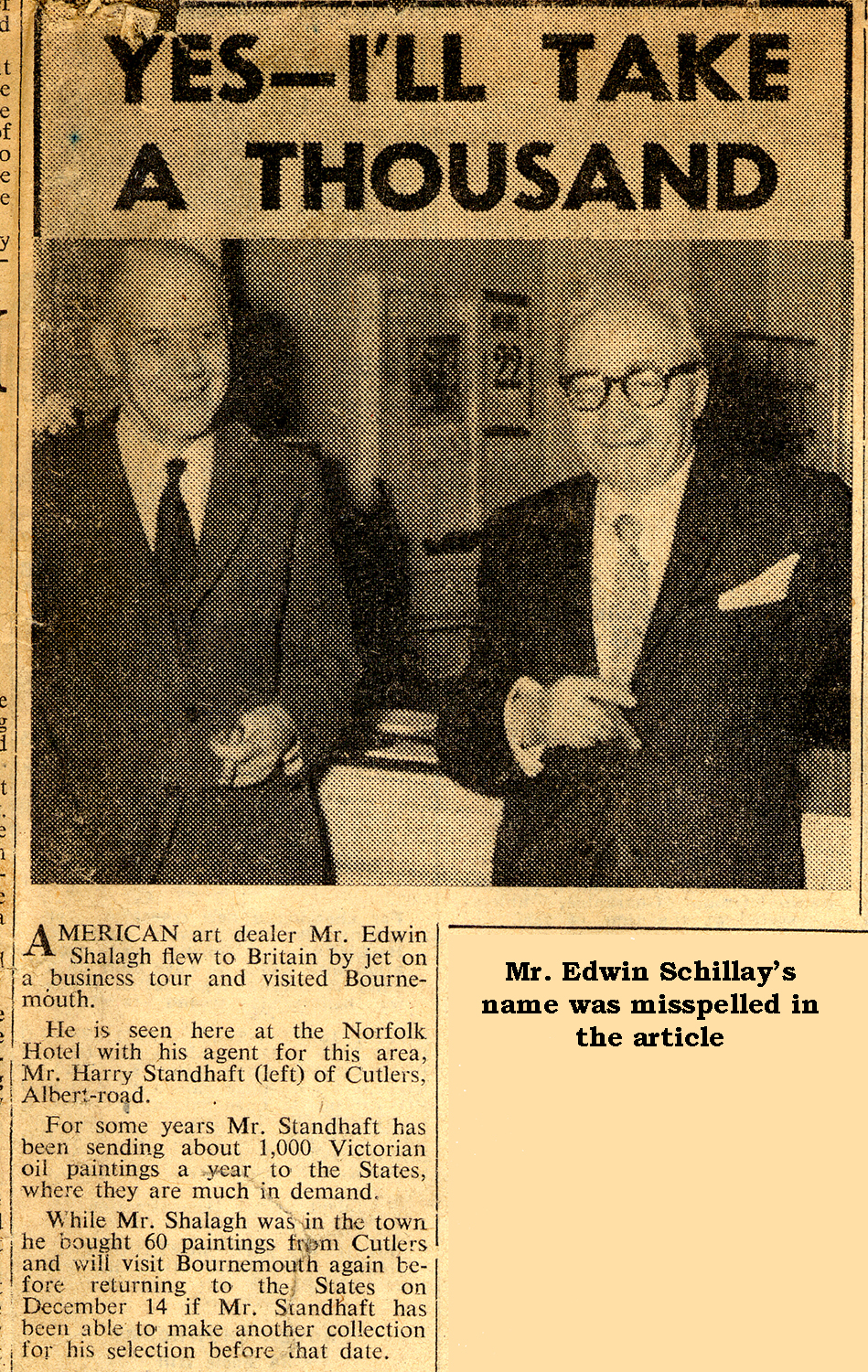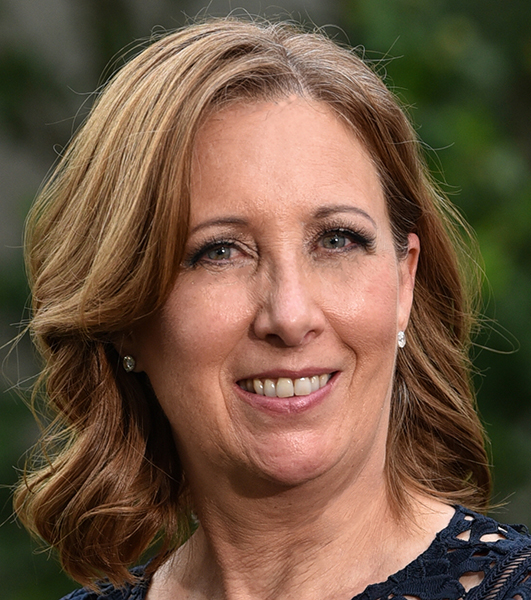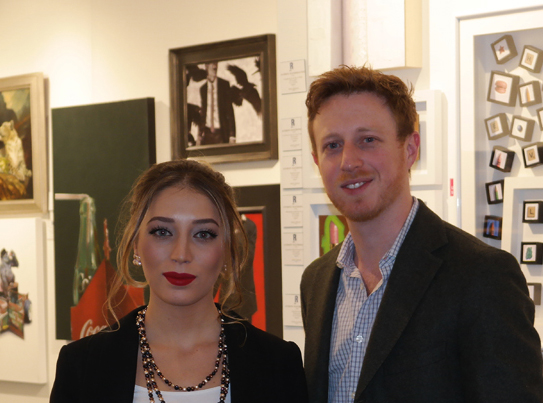
November 28, 1958
The story of Rehs Galleries begins in the late 1930s with M. Edwin Schillay, a young accountant, who decided to expand his business in an unexpected way. When one of his clients, an antique dealer based in Greenwich Village, suggested that he consider the art and antiques trade as a supplement to his accounting work, Schillay gave it serious thought. With a little guidance from his client, he traveled to London to investigate the art market and soon began purchasing paintings in bulk, packing 400-500 canvases into 7 x 7 x 10 foot containers called ‘lift vans’ and shipping them back to New York. From his space at the Manhattan Storage Warehouse, Schillay sold them to a variety of department stores that then featured the paintings in their art galleries. Although galleries within department stores disappeared in the 1970s, they were a standard element in these stores from their inception in Paris and New York in the 1850s. [i]
Throughout the 1940s, Schillay maintained his art business as an adjunct to his accounting firm. The war years naturally interrupted the normal flow of the art market, but he astutely continued to expand his network of contacts in the London art world as well as in the US. He purchased primarily nineteenth-century British paintings, pioneering the introduction of Victorian paintings to the American market through his bulk sales to department stores. After the war ended, Schillay gradually expanded his inventory to include artwork from other European countries.
In the mid-1950s, Schillay’s wife, Ruth, decided to take a more active role in the business, and opened a retail outlet at 303 Park Avenue South, redefining the business model to include sales to private individuals, and thus establishing the early roots of the art gallery as an independent enterprise. The scope of Schillay’s sources also expanded to include auctions and estate sales, reportedly acquiring as many as 60 paintings at one sale. [ii] During these years, the department store market was also booming. Advertisements from across the US reveal Schillay’s influence on the post-war American art market. For Stewart’s Department Store, The Baltimore Sun proclaimed: “Stewart’s presents a fabulous old collection by Great Masters and Artists from England, France, Germany, and Italy. ... Only Stewart’s brings you this magnificent art. TOMORROW. . . MEET MR. EDWIN SCHILLAY.” [iii] And from the Detroit Free Press comes the announcement that “Specially Priced 19th Century Oil Paintings from Old English estates” will be available at Hudson’s downtown department store only, where art lovers can view “dramatic 19th-century oil paintings that bespeak of charm, ease and grace with each stroke.” [iv] From New York to Dayton, Ohio, Schillay’s inventory of British paintings was a singular feature of department store galleries; he often traveled to personally assist in presenting the artwork to the public, no doubt introducing many customers to fine art for the first time. [v]
The selection of paintings that Schillay made available through the department stores focused primarily on nineteenth-century British artists who had originally painted for a clientele very similar to the twentieth-century American art buyer. Although many of the artists’ names were unfamiliar, they were nonetheless often well-respected painters in their own time. Edgar Bundy, for example, studied with the Belgian painter Alfred Stevens and then went on to exhibit his historical genre canvases at the Paris Salon and the Royal Academy in London. Likewise, Arthur Wardle was a successful painter of animals with over 100 works shown at the Royal Academy. Schillay’s promotion of these Victorian artists laid the groundwork for a reappraisal of mainstream British painting some twenty years later.

March 1972
386 Park Avenue South
The year 1960 marked another turning point. The gallery imported between 6000 and 7,000 paintings annually and consistently maintained an inventory of 2000 to 2,500 paintings on site. That called for a move to a larger space, this time to 386 Park Avenue South, just north of 27th Street. At this point, Schillay’s son-in-law, Joseph B. Rehs, joined the business partly because of his father-in-law’s failing health. Rehs, who was trained as an accountant, had married Ann Schillay in 1957.
Although he initially focused on accounting work for Schillay, Rehs recognized that the art business had significant potential for development. By 1961, he was fully immersed in broadening and refining the art business. Like his father-in-law before him, he traveled to Europe to learn from the art dealers there and to establish an international network of sources and customers. When Edwin Schillay died in January 1963, the next generation was fully prepared to maintain the business. The firm became known as Schillay & Rehs, Inc. a year later.

Joseph Rehs continued to specialize in nineteenth-century British painting, noting that many of these works were still affordable in the 1960s. He recalls, for example, his acquisition of a large figure painting by the genre artist Frederick Morgan (1856-1927) for $225—which he subsequently sold for $450. In 2000, the same painting was purchased several decades later for almost $1 million. Not only does this success reflect Rehs’ understanding of the art market, but it also underscores the early signs of a shift in the art historical analysis of Victorian art. Scholarly attention to the vast body of nineteenth-century art overlooked by previous generations also helped to foster an even stronger market for Schillay and Rehs, Inc.
Over the next two decades, Schillay & Rehs emerged as one of the largest importers of eighteenth and nineteenth-century European paintings. Increasingly, the client list included art galleries and an ever-growing group of department stores across the US. By the late 1960s, the gallery had a well-regarded track record in the art world. In fact, The Antique Dealer magazine sought out Schillay & Rehs’ opinion on the volatile art market in 1969, noting that their reporter “called on the owners of Schillay & Rehs, Inc., importers of 18th and 19th-century paintings for more than 30 years, and asked them to assess today’s market for old art.” [vi]
By 1978, the gallery moved once again. More spacious quarters at 305 East 63rd Street, New York, accommodated the large inventory, and more importantly, it signaled another stage of evolution in the business. As Joseph Rehs remarks, “We moved into the decorative arts trade then and began to sell to interior designers.” [vii] This meant a gradual transition out of the wholesale trade. Simultaneously, Rehs’ son, Howard, began studying art history at New York University, graduating in 1981 and joining the family that same year. As he remarked in a 2002 interview with Art & Antiques magazine, he started working in the packing room at age thirteen and “...never looked back. I love it all: buying selling, dealing with clients, doing research.” [viii]

Like his father and grandfather, Howard Rehs first went to London, where he spent a year living and working. He studied the European art market and purchased new inventory for the gallery. He returned not only with an understanding of the art business but also with an interest in French Academic, Realist, and Barbizon School art, which has remained a primary focus of the gallery since then. Over the course of the 1980s, the demand for nineteenth-century paintings increased significantly, pushing the market to ever higher prices. In response, Schillay & Rehs turned more and more to dealing with private clients, collectors, and museums. In 1991, the name of the business became Rehs Galleries, Inc., signaling not only new leadership but also the primary role of the company as an art gallery.
Howard Rehs also embarked on two major art historical projects in 1991. He had observed the substantial prices commanded by the work of Julien Dupré, a French nineteenth-century Naturalist painter, but discovered that little information about the artist was available. In searching for further historical background, he turned to the archival records at Knoedler’s gallery, which had handled Dupré’s sales in the US, and was pleased to find a wealth of sales records. [ix] With this information as a foundation, Rehs began the lengthy process of preparing the catalogue raisonné for Julien Dupré, collecting information about individual paintings and gradually establishing the historical development of the artist’s life and career. In 2015, Dr. Janet Whitmore also began working on the project, beginning with extensive research in France. Rehs Galleries’ commitment to creating a catalogue raisonné not only for Dupré but also for the American Naturalist painter Daniel Ridgway Knight established the gallery as an international resource on the work of these artists. Equally important is the contribution that Rehs Galleries has made—and continues to make—to art historical scholarship.
In 1997, Rehs Galleries established a new home base at 5 East 57th Street, New York. Joseph Rehs recalls the progression of the business from an accounting firm with a sideline in the art business to a well-respected twenty-first-century art gallery: “From the department store to the interior decorator to the individual guy. We moved from wholesale to buying at auctions.” With some delight, he also comments that “when we first moved into 57th Street, we had a new collector walk in and purchase a $300,000 painting!” [x] Clearly, the move to a more highly visible location was a positive change.
That same year, Howard Rehs became the president of the Fine Art Dealers Association (FADA), a position he held until 2009. Under his guidance, FADA’s membership expanded, and the Los Angeles Art Show took on a new role as one of the most important shows in the United States. He also highlighted the challenges of doing business in the online art market in 2001 when he caught another art dealer attempting to sell a work from Rehs Galleries without ever having purchased it in the first place. It proved to be a timely warning for art dealers in the digital age. [xi]

The importance of the Internet to art galleries became increasingly clear as more and more dealers developed an online presence. Rehs Galleries was no exception. The gallery website contains the expected inventory of artworks and background on the artists, but it also provides a monthly newsletter, Comments on the Art Market. Initially conceived of as a forum for guiding potential buyers on how to proceed wisely in the art market, the newsletter has now become a platform for analysis of the art market, commentary on auction sales and stock market news, as well as “tales from the dark side,” a monthly assessment of recent quirky, and occasionally criminal, news of the art world. The website also contains links to three online catalogue raisonné projects: Julien Dupré, Emile Munier (the gallery began this project in 2003), and Antoine Blanchard (started in 2007). [xii]
In the early 2000s, the gallery again welcomed additional family members to the business. As Joseph Rehs began considering retirement, his daughter-in-law Amy agreed to take on some of the operational responsibilities for the gallery, which had grown commensurate with the gallery’s clientele. The gallery’s long-standing representation of contemporary Realist artists also expanded after the turn of the twenty-first century. By 2010, Rehs represented approximately two dozen artists and exhibited the work of another 100 contemporary realists. With this level of commitment to contemporary Realism, Rehs established a separate corporation, Rehs Contemporary Galleries, Inc., in 2012.

The fourth generation of the family is now involved in running Rehs Contemporary Galleries. Since 2013, Alyssa and Lance Rehs, daughter and son of Amy and Howard, owners of the contemporary art business, have been involved in all aspects of the gallery. In a 2017 interview with LuxPop!, Alyssa explained that in addition to running the contemporary arm: “Lance and I have ramped up our social media platforms by posting original and interesting content daily. Additionally, we added a blog to our site, giving visitors news about the art market, gallery updates, and even advice for artists trying to navigate the art world.” [xiii]
In August of 2022, the gallery left their 57th Street location and eventually opened a new and much larger space at 20 West 55th Street in early 2023.
Realist art remains the focus of Rehs Galleries, Inc., but the scope of the business continues to evolve and expand in conjunction with the myriad currents of the art market. In describing the changes that emerged in his own years at the gallery, Joseph Rehs remarked, “When you hit a wall, you grow into the next phase.” [xiv] That sounds like a sage prescription for sustaining an art gallery for future generations.
[i] Le Bon Marché in Paris, which opened in 1852, was the first example of a modern department store. It was thoroughly described and analyzed as a social phenomena in Emile Zola’s novel, Au Bonheur des Dames (Ladies Paradise) (Paris: Charpentier, 1883). R. H. Macy & Company in New York opened in 1858 as a dry goods store, but quickly expanded into a department store. The success of the department store as a consolidated marketplace was an immediate success, both in Europe and the United States. Most of the prominent department stores in metropolitan areas contained art galleries.
[ii] “Yes--I’ll take a Thousand”, Bournemouth Times, November 28, 1958, 3d. Schillay purchased 60 paintings from Cutlers, Albert Road during his visit to the UK in 1958.
[iii] Stewarts Department store advertisement, The Baltimore Sun, Sunday, September 26, 1954.
[iv] J. L. Hudson Department store advertisement, Detroit Free Press, April 7, 1960.
[v] In Dayton, Ohio the advertisement included an announcement that “M. Edwin Schillay, New York importer of fine oil paintings will be here to assist with your selection.” Elder’s Department store advertisement, Dayton Daily News, November 1955. See also Macy’s Department store advertisement, New York Times, February 8, 1959.
[vi] The Antiques Dealer, April 1969: 34-35.
[vii] Interview with Joseph B. Rehs, August 2, 2017.
[viii] Claire Wilson, “Changing of the Guard” Art & Antiques, June 2002, 62-63.
[ix] Interview with Joseph B. Rehs, August 2, 2017.
[x] M. Knoedler & Company was founded as a New York branch of the Paris art dealer Goupil & Cie in 1848. The company closed in 2011. Today, the Knoedler Gallery Archive from 1848-1971 is housed at the Getty Research Institute in Malibu, California.
[xi] “Perceiving a New Threat to Dealers on the Internet, the President of the FADA Takes Matters into His Own Hands”, Antiques and the Arts Weekly, July 31, 2001. See www.antiquesandthearts.com.
[xii] See: https://emilemunier.org/ and https://antoineblanchard.org/
[xiii] Patricia Dobashi, “A Conversation with Alyssa Rehs of Rehs Galleries” LuxPop!, Issue 21. See www.rubylux.com/luxpop/Dealer-Spotlight-Issue-21]
[xiv] Interview with Joseph B. Rehs, August 2, 2017.
The gallery is involved in the following research projects
Virtual Catalogue Raisonné
Antoine Blanchard (1910 – 1988)
Julien Dupré (1851 - 1910)
Emile Munier (1840 - 1895)
Daniel Ridgway Knight (1839 - 1924)
GALLERY HOURS
October to May
Monday - Friday: 10:00am - 5:30 pm
June, July & September
Monday - Thursday: 10:00 am - 5:30 pm
August
Tuesday - Thursday: 10:00 am - 5:30 pm
All other times by appointment.
CONTACT INFORMATION
Rehs Galleries, Inc.
20 West 55th Street, 5th Floor
New York, NY 10019
Phone (212) 355-5710
Fax: (212) 355-5742
Follow us on Facebook,Instagram,Linked In and Twitter
MEMBERSHIPS
Antiques Council Howard L. Rehs, Board Member 2018 -
Art & Antique Dealers League of America
Association of Historians of Nineteenth-Century Art Howard L. Rehs, Honorary Life-time Member
Catalogue Raisonné Scholars Association
C.I.N.O.A
Internal Revenue Service’s Art Advisory Panel Howard L. Rehs, Member 2008-
LAPADA
